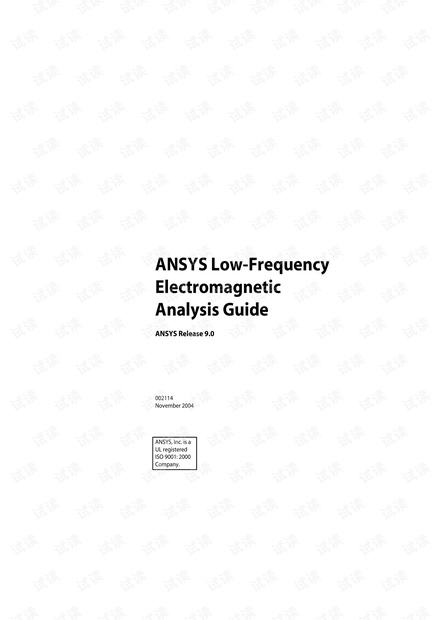没有合适的资源?快使用搜索试试~ 我知道了~
首页低频电磁分析指导 ANSYS Electromagnetic Analysis Guide
资源详情
资源评论
资源推荐

ANSYS Low-Frequency
Electromagnetic
Analysis Guide
ANSYS Release 9.0
002114
November 2004
ANSYS, Inc. is a
UL registered
ISO 9001: 2000
Company.

资料来源于网络,由翱翔 Aokee.com 整理,科研中国 SciEi.com 提供下载。取之于网络,用之于网络,为科学研究事业
发展尽一份力。版权归原作者所有,请读者勿用作商业用途,否则后果自负。
科研中国-中国科研网是科研
交流网站,希望广大科研工作者、学术期刊社,以及科研院、校、所与科研中国进行合作!
欢迎各领域专家和研究生,以及高校科研院所企业的科研人员来科研中国进行交流
!Email:chinamaker@sohu.com。
科研中国:http://www.SciEi.com,让中国引领世界共同进步。

ANSYS Low-Frequency
Electromagnetic Analysis Guide
ANSYS Release 9.0
ANSYS, Inc.
Southpointe
275 Technology Drive
Canonsburg, PA 15317
ansysinfo@ansys.com
http://www.ansys.com
(T) 724-746-3304
(F) 724-514-9494

Copyright and Trademark Information
Copyright © 2004 SAS IP, Inc. All rights reserved. Unauthorized use, distribution or duplication is prohibited.
ANSYS, DesignSpace, CFX, DesignModeler, DesignXplorer, ANSYS Workbench environment, AI*Environment, CADOE and any and all ANSYS, Inc. product
names referenced on any media, manual or the like, are registered trademarks or trademarks of subsidiaries of ANSYS, Inc. located in the United States or
other countries. ICEM CFD is a trademark licensed by ANSYS, Inc. All other trademarks and registered trademarks are property of their respective owners.
ANSYS, Inc. is a UL registered ISO 9001: 2000 Company.
ANSYS Inc. products may contain U.S. Patent No. 6,055,541.
Microsoft, Windows, Windows 2000 and Windows XP are registered trademarks of Microsoft Corporation.
Inventor and Mechanical Desktop are registered trademarks of Autodesk, Inc.
SolidWorks is a registered trademark of SolidWorks Corporation.
Pro/ENGINEER is a registered trademark of Parametric Technology Corporation.
Unigraphics, Solid Edge and Parasolid are registered trademarks of Electronic Data Systems Corporation (EDS).
ACIS and ACIS Geometric Modeler are registered trademarks of Spatial Technology, Inc.
FLEXlm License Manager is a trademark of Macrovision Corporation.
This ANSYS, Inc. software product and program documentation is ANSYS Confidential Information and are furnished by ANSYS, Inc. under an ANSYS
software license agreement that contains provisions concerning non-disclosure, copying, length and nature of use, warranties, disclaimers and remedies,
and other provisions. The Program and Documentation may be used or copied only in accordance with the terms of that license agreement.
See the ANSYS, Inc. online documentation or the ANSYS, Inc. documentation CD for the complete Legal Notice.
If this is a copy of a document published by and reproduced with the permission of ANSYS, Inc., it might not reflect the organization or physical appearance
of the original. ANSYS, Inc. is not liable for any errors or omissions introduced by the copying process. Such errors are the responsibility of the party
providing the copy.

Table of Contents
1. Overview of Magnetic Field Analysis .................................................................................................. 1–1
1.1. What Magnetic Analyses Do .......................................................................................................... 1–1
1.2. How ANSYS Handles Magnetic Analysis ......................................................................................... 1–2
1.3. Types of Static, Harmonic, and Transient Magnetic Analysis ........................................................... 1–8
1.4. Comparing Magnetic Formulations ............................................................................................... 1–8
1.4.1. 2-D Versus 3-D Magnetic Analysis ......................................................................................... 1–8
1.4.2. What Is the Magnetic Scalar Potential Formulation? .............................................................. 1–9
1.4.3. What Is the Magnetic Vector Potential Formulation? ............................................................. 1–9
1.4.4. What Is the Edge Formulation? ............................................................................................. 1–9
1.4.5. Comparing Formulations .................................................................................................... 1–10
1.4.6. Static Analysis .................................................................................................................... 1–10
1.5. Summary of Electromagnetic Elements ....................................................................................... 1–11
1.6. About GUI Paths and Command Syntax ....................................................................................... 1–13
2. 2-D Static Magnetic Analysis ............................................................................................................... 2–1
2.1. What Is Static Magnetic Analysis? .................................................................................................. 2–1
2.2. Elements Used in 2-D Static Magnetic Analysis .............................................................................. 2–1
2.3. Steps in a Static Magnetic Analysis ................................................................................................ 2–2
2.3.1. Creating the Physics Environment ........................................................................................ 2–3
2.3.1.1. Setting GUI Preferences ............................................................................................... 2–3
2.3.1.2. Defining an Analysis Title ............................................................................................. 2–3
2.3.1.3. Specifying Element Types and Options ........................................................................ 2–3
2.3.1.4. Defining the Element Coordinate System ..................................................................... 2–7
2.3.1.5. Defining Element Real Constants and a System of Units ............................................... 2–7
2.3.1.5.1. Choosing a System of Units for Your Analysis ....................................................... 2–7
2.3.1.6. Specifying Material Properties ..................................................................................... 2–8
2.3.1.6.1. Accessing Material Library Files ........................................................................... 2–8
2.3.1.6.2. Additional Guidelines for Defining Regional Material Properties and Real Con-
stants ............................................................................................................................... 2–9
2.3.1.7. For source conductor regions: .................................................................................... 2–12
2.3.1.8. For moving conductor regions: .................................................................................. 2–12
2.3.1.9. Real Constants for Moving Body Analysis ................................................................... 2–13
2.3.1.10. For Permanent Magnet Regions: .............................................................................. 2–14
2.3.1.11. For voltage-fed stranded coil regions: ...................................................................... 2–16
2.3.2. Building and Meshing the Model and Assigning Region Attributes ...................................... 2–17
2.3.3. Applying Boundary Conditions and Loads .......................................................................... 2–18
2.3.3.1. Boundary Conditions ................................................................................................. 2–19
2.3.3.1.1. Magnetic vector potentials (AZ) ........................................................................ 2–19
2.3.4. Excitation Loads ................................................................................................................. 2–19
2.3.4.1. Source Current Density (JS) ........................................................................................ 2–19
2.3.4.2. Voltage Drop (VLTG) .................................................................................................. 2–20
2.3.5. Flags .................................................................................................................................. 2–20
2.3.5.1. Force Flags ................................................................................................................ 2–20
2.3.5.2. Infinite Surface Flags (INF) .......................................................................................... 2–20
2.3.6. Other Loads ....................................................................................................................... 2–20
2.3.6.1. Current Segments (CSGX) .......................................................................................... 2–20
2.3.6.2. Maxwell Surfaces (MXWF) .......................................................................................... 2–21
2.3.6.3. Magnetic Virtual Displacements (MVDI) ...................................................................... 2–21
2.3.7. Solving the Analysis ........................................................................................................... 2–21
2.3.8. Defining the Analysis Type ................................................................................................. 2–22
2.3.9. Defining Analysis Options .................................................................................................. 2–22
ANSYS Low-Frequency Electromagnetic Analysis Guide . ANSYS Release 9.0 . 002114 . © SAS IP, Inc.
剩余401页未读,继续阅读
ickingdom
- 粉丝: 1
- 资源: 7
上传资源 快速赚钱
 我的内容管理
收起
我的内容管理
收起
 我的资源
快来上传第一个资源
我的资源
快来上传第一个资源
 我的收益 登录查看自己的收益
我的收益 登录查看自己的收益 我的积分
登录查看自己的积分
我的积分
登录查看自己的积分
 我的C币
登录后查看C币余额
我的C币
登录后查看C币余额
 我的收藏
我的收藏  我的下载
我的下载  下载帮助
下载帮助

会员权益专享
最新资源
- RTL8188FU-Linux-v5.7.4.2-36687.20200602.tar(20765).gz
- c++校园超市商品信息管理系统课程设计说明书(含源代码) (2).pdf
- 建筑供配电系统相关课件.pptx
- 企业管理规章制度及管理模式.doc
- vb打开摄像头.doc
- 云计算-可信计算中认证协议改进方案.pdf
- [详细完整版]单片机编程4.ppt
- c语言常用算法.pdf
- c++经典程序代码大全.pdf
- 单片机数字时钟资料.doc
- 11项目管理前沿1.0.pptx
- 基于ssm的“魅力”繁峙宣传网站的设计与实现论文.doc
- 智慧交通综合解决方案.pptx
- 建筑防潮设计-PowerPointPresentati.pptx
- SPC统计过程控制程序.pptx
- SPC统计方法基础知识.pptx
资源上传下载、课程学习等过程中有任何疑问或建议,欢迎提出宝贵意见哦~我们会及时处理!
点击此处反馈



安全验证
文档复制为VIP权益,开通VIP直接复制
 信息提交成功
信息提交成功
评论2